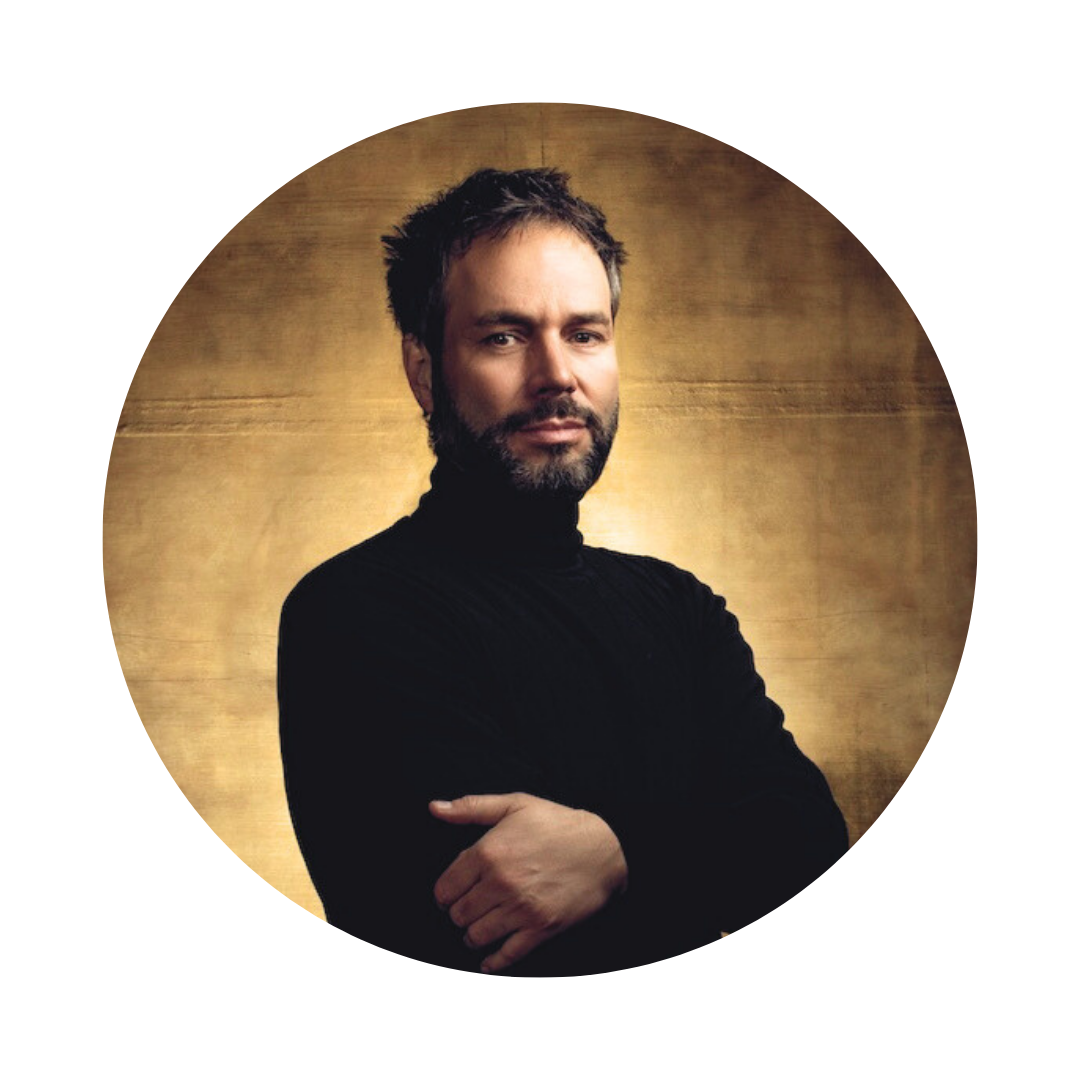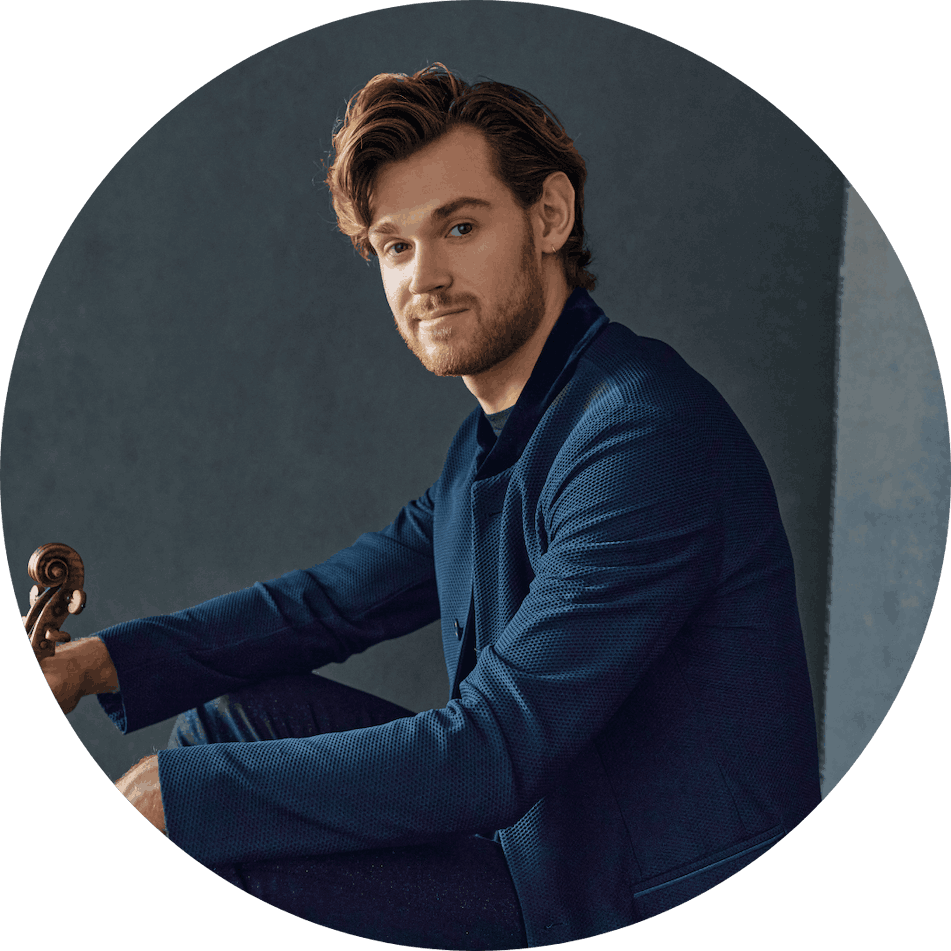Latin Rhythms & Hollywood Drama
Josep Vicent, conductor
Blake Pouliot, violin
Griset Damas-Roche, flamenco dancer
| • • • • • • • • • • • • • • • • • • • • • • • • • • • • • • | ||
| Falla | The Three Cornered Hat | |
| Korngold | Concerto in D Major for Violin and Orchestra, Op. 35 I. Moderato mobile II. Andante III. Finale: Allegro assai vivace | |
| Blake Pouliot, violin | ||
INTERMISSION | ||
| Falla | El amor brujo: Ballet Suite | |
| Griet Damas-Roche, flamenco dancer | ||
| Márquez | Danzón No. 2 | |
Josep Vicent

Josep Vicent is a musician with an extensive international career leading some of the most prestigious orchestras in Spain and around the world. With his fresh and captivating style together with an strong commitment to music making he conducted London Symphony Orchestra, New World Symphony Miami, Royal Liverpool Philharmonic, Rotterdam Philharmonic Orkest, Mariinsky Theatre Orchestra, Radio Metropol Orkest, Royal Philharmonic Orchestra, Residentie Orkest, Paris Chamber Orchestra, Orquesta Nacional de España, Orquestra de Barcelona i Nacional de Catalunya, National Symphonies of Belgium, Chile, and Brazil, among others.
He has received multiple international recording prizes and was Nominated for the GRAMMY and Latin GRAMMY in 2023 and 2024 for the second consecutive year for his albums Ritmo and The Latin Rites with ADDA Simfònica.
He was also the Artistic Director of Slagwerkgroep Amsterdam Xenakis Festival, principal conductor of the Orquestra Simfònica de les Illes Balears, and Music Director of the Jeunesses Musicales World Orchestra for 15 years, with whom he toured extensively across four continents. Since 2015, he has been the artistic and principal conductor of ADDA Simfònica Alicante, touring with them in Germany, Spain (including Ibermúsica Series in Madrid and Barcelona), France (including succesfull debuts and returns to the Berlioz festival), and Slovenia (with repeated performances at Ljubljiana Festival). In november 2025 they will tour Japan extensively including several performances at Suntory Hall Tokio and Osaka.
In recent seasons, he debuted with the Buenos Aires Philharmonic, WDR, Orchestre National de Lille, and Arthur Rubinstein Philharmonic. The 2024/25 season includes his return with the Aargau Symphony Orchestra in Switzerland, the Valencia Symphony Orchestra, the Orquesta Sinfonica de Milano, and his debut with the Slovak Philharmonic and Arturo Toscanini Philharmonic, among others.
Since 2014, he has worked as Musical Director with La Fura dels Baus. Josep Vicent has conducted at the Rouen Opera, Teatro Colón, Teatro Real, Liceu Opera House, La Monnaie Opera, Leipzig Opera, Mariinsky Theatre, Teatro de la Maestranza, Teatro Arriaga, and numerous festivals around the world. He is a recipient of the National Youth Music Award, the “City of Valencia” Arts Award, the Oscar Esplá Award, and was named Ambassador of the Foundation for a Culture of Peace. His extensive discography is available through Deutsche Grammophon, Aria, and Warner Classics, with whom he currently records.
Blake Pouliot

Described as “immaculate, at once refined and impassioned,” (ArtsAtlanta) violinist Blake Pouliot (pool-YACHT) has anchored himself among the ranks of classical phenoms. A tenacious young artist with a passion that enraptures his audience in every performance, Pouliot has established himself as “one of those special talents that comes along once in a lifetime” (Toronto Star). Blake Pouliot’s 2024-2025 symphonic highlights include debuts with the LA Philharmonic at the Hollywood Bowl, San Diego Symphony, as well as the Houston Symphony, Grand Rapids Symphony, Rhode Island Philharmonic and the San Antonio Symphony. Blake expands his presence in Europe this season with performances with the London Philharmonic and Alevtina Ioffe, Chamber Orchestra of Europe with conductor Mattias Pintscher and cellist Alisa Weilerstein, KYMI Sinfonietta, and Orchestre National des Pays de la Loire.
During his time as Soloist-in-Residence of Orchestre Métropolitain in 2020/21, Pouliot and Yannick Nézet-Séguin performed Mozart’s Violin Concerto No. 5 and Piazzolla’s The Four Seasons which led to Pouliot’s 2022 debut with the Philadelphia Orchestra at the Kimmel Center, performing John Corigliano’s The Red Violin (Chaconne for Violin and Orchestra) with Nézet- Séguin. Highlights elsewhere include Beethoven’s Triple Concerto with Orchestre Symphonique de Montréal in 2022/23, with Angela Hewitt and Bryan Cheng, as well as performances of the Paganini, Mendelssohn, Saint-Saëns concerti and Bruch’s Scottish Fantasy in subscription series across North America.
Pouliot released his debut album of 20th century French music on Analekta Records in 2019. Featuring Ravel’s Tzigane and Violin Sonata in G, Debussy’s Violin Sonata in G minor and Beau Soir, the recording received critical acclaim including a five-star rating from BBC Music Magazine and a 2019 Juno Award nomination for Best Classical Album.
Since his orchestral debut at age 11, Pouliot has performed with the orchestras of Aspen, Atlanta, Detroit, Dallas, Madison, Montreal, Toronto, San Francisco, and Seattle, among many others. Internationally, he has performed as soloist with the Sofia Philharmonic in Bulgaria, Orchestras of the Americas on its South American tour, and was the featured soloist for the first ever joint tour of the European Union Youth Orchestra and National Youth Orchestra of Canada. He has collaborated with many musical luminaries including conductors Sir Neville Marriner, David Afkham, Pablo Heras-Casado, David Danzmayr, JoAnn Falletta, Marcelo Lehninger, Nicholas McGegan, Alexander Prior, Vasily Petrenko, and Thomas Søndergård.
Pouliot has been featured twice on Rob Kapilow’s What Makes it Great? series and has been NPR’s Performance Today Artist-in-Residence in Minnesota (2017/18), Hawaii (2018/19), and across Europe (2021/22). Prior to that, he won the Grand Prize at the 2016 Orchestre Symphonique de Montréal Manulife Competition and was named First Laureate of both the 2018 and 2015 Canada Council for the Arts Musical Instrument Bank.
Pouliot performs on the 1729 Guarneri del Gesù on generous loan from an anonymous donor.
Griset Damas-Roche

Griset Damas-Roche is a Havana-born Flamenco dancer, choreographer, and artistic director with over 25 years of international experience. Trained in Ballet at the Instituto Superior de Arte de La Habana, she started Flamenco dance in Ballet Español de Cuba, where she achieved soloist grade and did her first steps playing Castanets.
Griset has also studied Flamenco with very renowned masters and institutions and keeps the discipline to study every year at Flamenco festivals or special training events in Spain.
She has performed with major orchestras, including the Bogota Philharmonic and National Symphony of Colombia. Since she resides in Ohio, she has performed with Columbus Symphony Orchestra, Chautauqua Symphony Orchestra, and Princeton Symphony Orchestra.
At this time, Griset directs Caña Flamenca and U Will Dance Studio, sharing authentic Flamenco through performances and education. Her dynamic artistry blends technical precision with deep emotional expression, bringing the passion of Flamenco to concert stages worldwide.
“Jota” from The Three-Cornered Hat, Suite II (1917)
by Manuel de Falla (Cádiz, Spain, 1876 - Alta Gracia, Argentina, 1946)
Manuel de Falla had a deep love for the folk music of his native Spain, but also the ambition to transcend nationalism in a narrow sense and be universally European both in outlook and in technique. From 1907-14, Falla lived in Paris where he came into contact with some of the most exciting musical developments of the day. Upon his return to Spain, he entered a period of intense creativity that resulted in a unique synthesis: his mature works build, in equal measure, on his early exposure to folk music, his systematic study of all aspects of Spanish tradition under the composer and musicologist Felipe Pedrell, and finally the Paris experience that had greatly broadened his horizons.
Falla had long known the story of The Three-Cornered Hat. It was an old folktale, adapted by the poet and novelist Pedro Antonio de Alarcón (1833-1891) in his novel The Magistrate and the Miller's Wife. In the story, a lecherous magistrate tries to seduce the miller’s wife but fails and ends up being humiliated.
Falla’s music for The Three-Cornered Hat initially took the form of a pantomime, titled EL Corregidor y la molinera, premiered at the Teatro Eslava in Madrid on April 7, 1917. At the request of Serge Diaghilev, the director of the famous Ballets Russes, Falla revised and expanded the work, re-scoring the original chamber-ensemble accompaniment to a full-size symphony orchestra. The new version opened in London in 1919, with Léonide Massine in the role of the miller, and sets and costumes by Picasso, under the new title The Three-cornered Hat.
Falla drew two concert suites from the ballet, which contain the bulk of the entire score. The second suite is made up of three dance movements, of which the last is a jota, a rapid triple-time dance primarily associated with the region of Aragon. A string of irresistible Spanish melodies is orchestrated in a way inspired by French music, complete with harps and muted horns. Simple themes are chromatically inflected in a most ingenious way, infusing the authentic voice of Spain with modernistic elements. The prestigious Diaghilev production of The Three-Cornered Hat turned Falla into a European celebrity to a degree hardly ever matched by a Spanish composer either before or after him.
Violin Concerto in D major, Op. 35 (1937-39, rev. 1945)
by Erich Wolfgang Korngold (Brünn, Moravia, Austro-Hungarian Monarchy [now Brno, Czech Republic], 1897 - Hollywood, California, 1957)
When Erich Wolfgang Korngold was nine years old, his father—who happened to be Julius Korngold, the most influential music critic in Vienna—showed the boy’s first compositions to Gustav Mahler, the latter exclaimed: ‟A genius!” Mahler’s reaction was understandable. The young Korngold was a unique composing prodigy who had an instinctive grasp of the most modern musical styles of the day. He grew up to be an extremely successful opera composer—his most talked-about work, Die tote Stadt (‟The Dead City”), was written when he was twenty. He was equally attracted to operetta, and was considered an expert on Johann Strauss, Jr. His involvement with new productions of Die Fledermaus and other Strauss operettas (as arranger and conductor) became legendary, and brought him into contact with Max Reinhardt (1873-1943), the foremost German stage director of the time. This turned out to be a life-saver, as it was with Reinhardt that Korngold first went to Hollywood, where he soon became the star among film composers. After the Nazi occupation of Austria in 1938, Korngold lost his original home base and settled permanently in Los Angeles.
His father, who in his seventies was forced to flee Austria and joined his son in Southern California, was deeply disappointed that Erich had given up ‟serious” composition in favor of the movies. To his last day, the old man kept exhorting his son to return to concert music. His advice went unheeded for years, yet towards the end of Julius’s life, Erich wrote a string quartet (his third) and, after his father’s death, he returned to a project started years earlier but never completed: a concerto for violin and orchestra.
The great violinist Bronislaw Huberman—an old family friend since Vienna days—had long been asking Korngold for a violin concerto. When the work was finally completed, however, Huberman found himself unable to commit to a performance date. (The Polish violinist was in poor health and died in June 1947 at the age of 64). Korngold showed the concerto to Jascha Heifetz, who learned it within a few weeks and, with Huberman’s blessing, gave the world premiere in St. Louis on February 15, 1947.
At this point in Korngold’s career, the two aspects of his creative world—concert and film music—had become completely intertwined. His movie scores (Captain Blood, The Adventures of Robin Hood) were symphonic, even operatic, in their scope. The Violin Concerto, conversely, owes much to Korngold’s work in the film industry. Many of the major themes were taken over from movie scores, and there are moments where the instrumentation and the thematic development also bring back Hollywood memories.
The opening theme of the concerto comes from a score written for a film that failed and was quickly forgotten (Another Dawn, 1937), the second from the historical movie Juarez (1939). The folk-dance theme of the last movement originated in the film adaptation of Mark Twain’s The Prince and the Pauper (1937), and became the starting point for a set of brilliant variations. These different sources form a completely new entity in the Violin Concerto, quite independent from the screen originals. (The beautiful melody of the second-movement ‟Romance” seems to have been written especially for this concerto.)
In Korngold’s personal style, elements inherited from Mahler and Richard Strauss are treated with the light touch perfected at the Warner Brothers studios. This approach brought Romantic concerto-writing to new life at a time when most modern composers and critics were ready to bury it. Korngold himself never had any doubts about the vitality of this tradition. His rich melodic invention, his ‟spicy” harmonies that nevertheless remain firmly anchored in tonality, and his perfect understanding of the virtuoso violin idiom enabled him to make an important contribution to the repertoire. Yet at first, the concerto found little favor with violinists, despite Heifetz’s strong advocacy. (Heifetz recorded the work twice: once with the New York and once with the Los Angeles Philharmonic.) Since the 1970s, Korngold’s Violin Concerto has become part of the standard repertoire, with numerous recordings and frequent concert performances all over the world.
El amor brujo (“Love, the Sorcerer,” 1914-24)
by Manuel de Falla (Cádiz, Spain, 1876 - Alta Gracia, Argentina, 1946)
Manuel de Falla was already well established as the foremost Spanish composer of his generation when he was approached by the famous flamenco dancer, Pastora Imperio, with a request to write a piece for her troupe. Since Imperio was an accomplished vocalist as well as a dancer, the protagonist had to sing as well as dance in the new work. Falla and Imperio worked with a libretto that was credited to Gregorio Martínez Sierra a highly regarded playwright and poet–although it was actually written, at least in part, by Martínez Sierra’s wife, María Lejárraga, a prominent author in her own right. Their work made use of some old fables told by Imperio’s mother, Rosario la Mejorana, herself a celebrated flamenco dancer.
In the story, a Gypsy woman named Candelas is haunted by the ghost of her murdered husband José (who had cheated on her while he was alive). The ghost forces Candelas to dance with him every night, getting in the way of her romance with Carmelo (with whom she had been in love before her family married her off to José). Even the magic fire ritual does not succeed in exorcising the ghost. It is only when José’s old lover appears and distracts the ghost that the love between the two protagonists can finally flourish.
El amor brujo went through a number of versions over the years. The original 1915 production was a gitanería or Gypsy entertainment, with spoken dialog, flamenco singing and dancing. Unsuccessful as a play, the music was revised for classical singer and orchestra in 1916 and again in 1924, as a ballet pantomímico using a larger orchestra. This last version has become the standard form of the work in which is most frequently performed.
This final version, which will also be heard at this weekend’s concerts, consists of thirteen sections, some of which are extremely brief. It includes the “Dance of Terror,” the ever-popular “Ritual Fire Dance,” the “Dance of the Game of Love,” as well as three vocal numbers, sung in Andalusian Spanish. In Falla’s music, the sounds of flamenco are combined with French impressionist influences; the resulting fusion of styles is a perfect vehicle for the mixture of passion, folklore and the occult that gives this ballet pantomímico its unique flavor.
Danzón No. 2 (1994)
by Arturo Márquez (b. Álamos, Sonora, Mexico, 1950)
|
|
In the 31 years since its premiere, Arturo Márquez’s Danzón No. 2 has enjoyed immense success, not only in Mexico, where some have even called it a ‟second national anthem,” but internationally as well. That is hardly surprising, since the piece takes a string of irresistible Mexican dances, of the kind one would normally hear at a dance hall, played by an orquesta típica or a mariachi band, and presents them in the full colors of a large symphony orchestra. The effect is quite spectacular!
The danzón, of Cuban origin, is in the Latin world what the waltz is in Europe. A stately couple dance that is considered the main event at any ball, it starts slowly and allows for some close contact between the dancers, but eventually speeds up and can get quite fiery towards the end. Aaron Copland had earlier been inspired by the danzón in his Danzón Cubano (1942). Márquez has now made it into one of his signature genres; to date, he has completed no fewer than nine danzones.
Danzón No. 2 was written in early 1994 during the Zapatista uprising, which fought for the rights of the impoverished indigenous populations in Mexico. This circumstance, which the composer himself has pointed out, lends an added emotional charge to the work as it progresses from a haunting clarinet solo at the beginning to a passionate conclusion.
Notes by Peter Laki



